Disdyakis dodecahedron
| Disdyakis dodecahedron | |
|---|---|
 Click on picture for large version Spinning version | |
| Type | Catalan solid |
| Conway notation | mC |
| Coxeter diagram | |
| Face polygon |  scalene triangle |
| Faces | 48 |
| Edges | 72 |
| Vertices | 26 = 6 + 8 + 12 |
| Face configuration | V4.6.8 |
| Symmetry group | Oh, B3, [4,3], *432 |
| Dihedral angle | 155° 4' 56" |
| Dual polyhedron | truncated cuboctahedron |
| Properties | convex, face-transitive |
 Net | |
In geometry, a disdyakis dodecahedron, or hexakis octahedron or kisrhombic dodecahedron[1]), is a Catalan solid with 48 faces and the dual to the Archimedean truncated cuboctahedron. As such it is face-transitive but with irregular face polygons. It superficially resembles an inflated rhombic dodecahedron—if one replaces each face of the rhombic dodecahedron with a single vertex and four triangles in a regular fashion one ends up with a disdyakis dodecahedron. More formally, the disdyakis dodecahedron is the Kleetope of the rhombic dodecahedron.
Symmetry
It has Oh octahedral symmetry. Its collective edges represent the reflection planes of the symmetry. It can also be seen in the corner and mid-edge triangulation of the regular cube and octahedron, and rhombic dodecahedron.
 Disdyakis dodecahedron |
 Spherical |
 Cubic |
 Octahedral |
 Rhombic dodecahedral |
Seen in stereographic projection the edges of the disdyakis dodecahedron form 9 circles (or centrally radial lines) in the plane. The 9 circles can be divided into two groups of 3 and 6 (drawn in purple and red), representing in two orthogonal subgroups: [2,2], and [3,3]:
| Orthogonal | Stereographic | ||
|---|---|---|---|
 |
 |
 |
 |
| [4] | [3] | [2] | |
Dimensions
If its smallest edges have length 1, its surface area is and its volume is .
Orthogonal projections
The truncated cuboctahedron and its dual, the disdyakis dodecahedron can be drawn in a number of symmetric orthogonal projective orientations. Between a polyhedron and its dual, vertices and faces are swapped in positions, and edges are perpendicular.
| Projective symmetry |
[4] | [3] | [2] | [2] | [2] | [2] | [2]+ |
|---|---|---|---|---|---|---|---|
| Image |  |
 |
 |
 |
 |
 |
 |
| Dual image |
 |
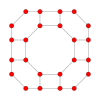 |
 |
 |
 |
 |
 |
Related polyhedra and tilings
The disdyakis dodecahedron is one of a family of duals to the uniform polyhedra related to the cube and regular octahedron.
| Uniform octahedral polyhedra | ||||||||||
|---|---|---|---|---|---|---|---|---|---|---|
| Symmetry: [4,3], (*432) | [4,3]+ (432) |
[1+,4,3] = [3,3] (*332) |
[3+,4] (3*2) | |||||||
| {4,3} | t{4,3} | r{4,3} r{31,1} |
t{3,4} t{31,1} |
{3,4} {31,1} |
rr{4,3} s2{3,4} |
tr{4,3} | sr{4,3} | h{4,3} {3,3} |
h2{4,3} t{3,3} |
s{3,4} s{31,1} |
= |
= |
= |
||||||||
| Duals to uniform polyhedra | ||||||||||
| V43 | V3.82 | V(3.4)2 | V4.62 | V34 | V3.43 | V4.6.8 | V34.4 | V33 | V3.62 | V35 |
It is a polyhedra in a sequence defined by the face configuration V4.6.2n. This group is special for having all even number of edges per vertex and form bisecting planes through the polyhedra and infinite lines in the plane, and continuing into the hyperbolic plane for any
With an even number of faces at every vertex, these polyhedra and tilings can be shown by alternating two colors so all adjacent faces have different colors.
Each face on these domains also corresponds to the fundamental domain of a symmetry group with order 2,3,n mirrors at each triangle face vertex.
| *n32 symmetry mutations of omnitruncated tilings: 4.6.2n | ||||||||||||
|---|---|---|---|---|---|---|---|---|---|---|---|---|
| Sym. *n32 [n,3] |
Spherical | Euclid. | Compact hyperb. | Paraco. | Noncompact hyperbolic | |||||||
| *232 [2,3] |
*332 [3,3] |
*432 [4,3] |
*532 [5,3] |
*632 [6,3] |
*732 [7,3] |
*832 [8,3] |
*∞32 [∞,3] |
[12i,3] |
[9i,3] |
[6i,3] |
[3i,3] | |
| Figures |  |
 |
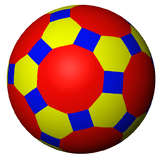 |
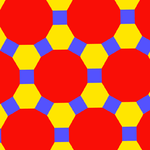 |
 |
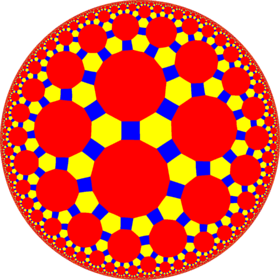 |
 |
 |
 |
 |
 | |
| Config. | 4.6.4 | 4.6.6 | 4.6.8 | 4.6.10 | 4.6.12 | 4.6.14 | 4.6.16 | 4.6.∞ | 4.6.24i | 4.6.18i | 4.6.12i | 4.6.6i |
| Duals | 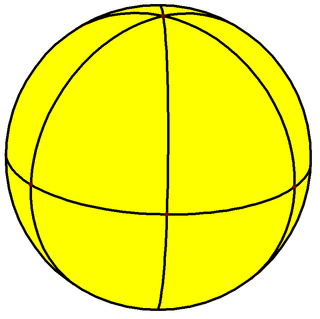 |
 |
 |
 |
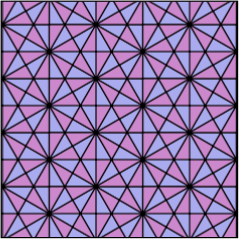 |
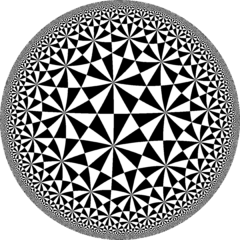 |
 |
 |
 |
 |
 |
 |
| Config. | V4.6.4 | V4.6.6 | V4.6.8 | V4.6.10 | V4.6.12 | V4.6.14 | V4.6.16 | V4.6.∞ | V4.6.24i | V4.6.18i | V4.6.12i | V4.6.6i |
| *n42 symmetry mutation of omnitruncated tilings: 4.8.2n | ||||||||
|---|---|---|---|---|---|---|---|---|
| Symmetry *n42 [n,4] |
Spherical | Euclidean | Compact hyperbolic | Paracomp. | ||||
| *242 [2,4] |
*342 [3,4] |
*442 [4,4] |
*542 [5,4] |
*642 [6,4] |
*742 [7,4] |
*842 [8,4]... |
*∞42 [∞,4] | |
| Omnitruncated figure |
 4.8.4 |
 4.8.6 |
 4.8.8 |
 4.8.10 |
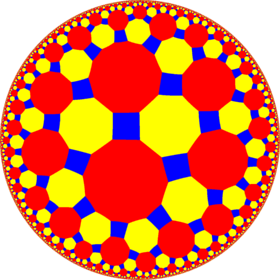 4.8.12 |
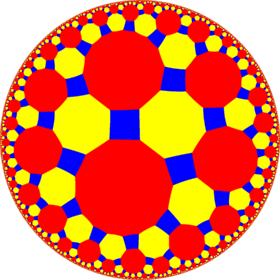 4.8.14 |
 4.8.16 |
 4.8.∞ |
| Omnitruncated duals |
 V4.8.4 |
 V4.8.6 |
 V4.8.8 |
 V4.8.10 |
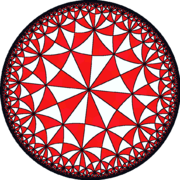 V4.8.12 |
 V4.8.14 |
 V4.8.16 |
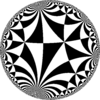 V4.8.∞ |
See also
- First stellation of rhombic dodecahedron
- Disdyakis triacontahedron
- Kisrhombille tiling
- Great rhombihexacron—A uniform dual polyhedron with the same surface topology
References
- ↑ Conway, Symmetries of things, p.284
- Williams, Robert (1979). The Geometrical Foundation of Natural Structure: A Source Book of Design. Dover Publications, Inc. ISBN 0-486-23729-X. (Section 3-9)
- The Symmetries of Things 2008, John H. Conway, Heidi Burgiel, Chaim Goodman-Strass, ISBN 978-1-56881-220-5 (Chapter 21, Naming the Archimedean and Catalan polyhedra and tilings, page 285, kisRhombic dodecahedron)
External links
- Eric W. Weisstein, Disdyakis dodecahedron (Catalan solid) at MathWorld.
- Disdyakis Dodecahedron (Hexakis Octahedron) Interactive Polyhedron Model